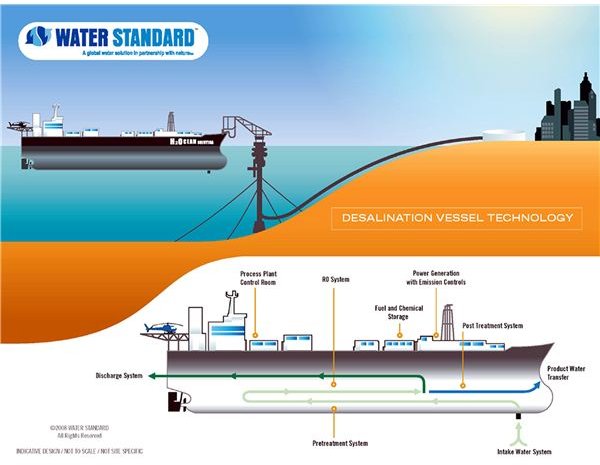About Desalination Ships
Introduction: Sea Water Desalination Vessel (SDV)
This type of desalination has long been employed used in merchant ships in past years to generate the fresh water to satisfy the regular need on board the ship. Using the same concept, the “Water Standard Company“ came up with the idea of creating a desalination vessel that is purely meant to generate fresh water onboard the ship. This is environmentally friendly and also is an alternative solution for land-based desalination technologies.
The need for desalination increases due to the following reasons:
- Increase in global water usage due to population increases.
- Pollution of the rivers and drying up of rivers.
- Improper rainfall causes water shortages.
Technology Used in Sea Water Desalination Vessels
In this technology we make use of the old tankers and crude oil carriers that have undergone a conditional assessment survey stating that the vessel cannot be further used to carry oil or oily products due to its reduced hull thickness. These vessels are purchased and modified into seawater desalination vessels.
The modification is done in dry dock where the cargo tanks are converted into the fresh water storage tanks, and we install the new sets of reverse osmosis plants for desalination of the sea water. To make it drinkable, we used the water treatment plants like chlorine sterilization conditioning, the Electro-Katadyn method of sterilization, and the use of UV filters to remove bacteria and other microorganisms from the fresh water. The treated water is then stored in the storage tanks and kept ready for discharge at appropriate water platforms.
On the shore, we built water platform-like structures where the ship is able to reach the platform and deliver the fresh water to the shore through a flexible cable connecting the ship’s discharge to the shore side tanks.
Normally the platforms are built near to the shore at the distance of (1-2 km) as the ship can directly come to the platform and pump out the fresh water to the shore tanks.
These platforms are built at equal intervals on every city near to shore, as it can supply freshwater to those cities at a regular intervals of time, say about twice a week.
Sea Water Desalination Vessel:
Advantages of Seawater Desalination Vessel Technology
- SDV is reliable water source even under the extreme weather conditions.
- It is mobile which reduces the cost of transportation of the produced fresh water, as in the case of land-based desalination systems fresh water in the plant has to be transported from the production place to nearby cities by land. As transporting through land is very costly, instead we can install new fresh water platforms on the shore near city as it is cost effective for transportation by sea.
- Construction of the desalination vessel is cheap because it is modified from a tanker, and erecting the platform is also cost effective because it is near to the shore where the depth of water will be less.
- These vessels make use of both the type of desalination methods of evaporation type and Reverse osmosis RO type. The vessels are driven by marine diesel engines which have a high jacket cooling water temperature sufficient for waste heat to generate the fresh water through an evaporator type of desalination plant. Thus it is also an energy efficient system using the waste heat from the running engine to generate fresh water.
- These vessels generate their own power, which reduces transmission losses between the power grid and the desalination plant.
- The ships can supply fresh water to one or more cities as it can be moored near the shore.
- It reduces the amount of chemicals used to pretreatment of the water as the sea water is not taken from close to the shore, which reduces pretreatment costs as the power, chemical, and waste disposal is far less in deep waters.
- It has a minimal environmental impact compared to land-based desalination plants, as in land based sea water desalination plants it discharges the waste brine solution near by the shore which will contained the pretreated chemical in turn it will affect the local ecosystem. This does not happen in the SDV as it desalination process is carried out during its voyage so it reduces the pretreatment chemicals being used and the discharge of brine solution is being carried out at a constant discharge rate while the ship in enroute. This kind of discharge will not effect the local ecosystem.
- Its processing is fast and less complex than the land based desalination system.
Credits:
For More Information Visit :https://www.waterstandard.com
Image Credit:
